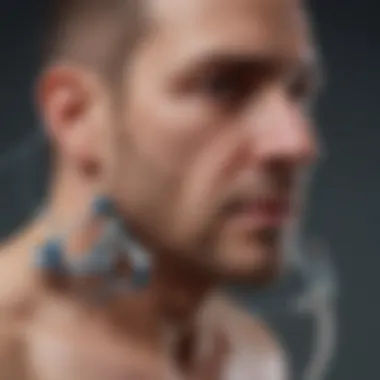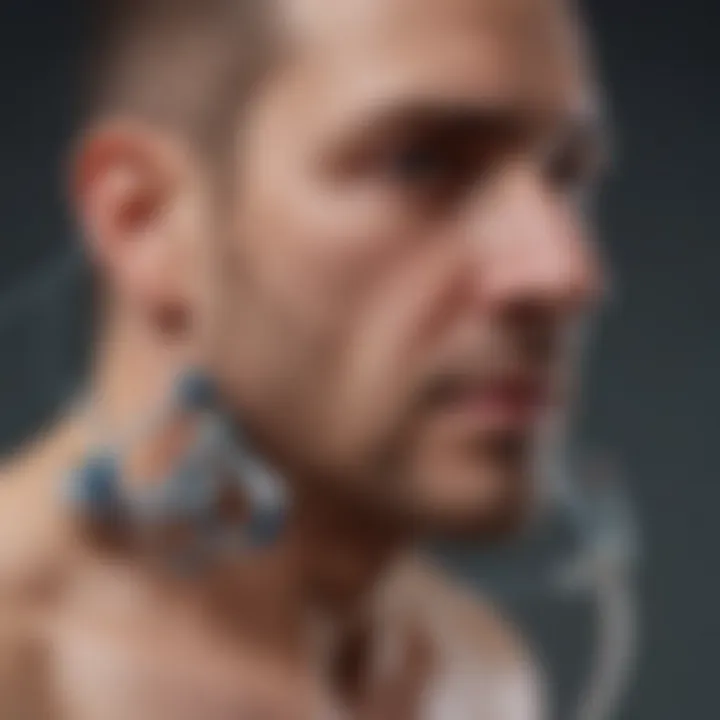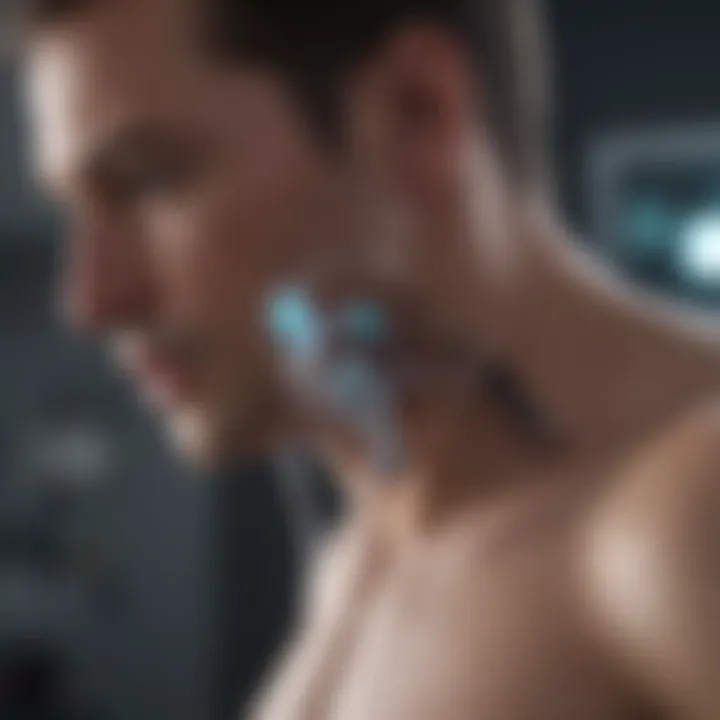Virtual Bronchoscopy: An In-Depth Exploration


Intro
Virtual bronchoscopy is an innovative imaging technique transforming how respiratory conditions are diagnosed and managed. It employs computed tomography (CT) scans to create detailed, three-dimensional maps of the bronchial trees. This process allows healthcare professionals to visualize airways and lung structures without resorting to invasive techniques. As clinicians seek more effective diagnostic tools, the relevance of virtual bronchoscopy is undeniable.
This article provides a thorough examination of virtual bronchoscopy, focusing on its technical foundations, clinical applications, advantages, limitations, and potential future developments in pulmonary diagnostics.
Article Overview
Summary of Key Findings
Virtual bronchoscopy has shown substantial promise in various clinical settings. Key findings include:
- Enhanced visualization of airway pathologies, such as tumors and strictures.
- Reduction in patient discomfort associated with traditional procedures, such as flexible bronchoscopy.
- A valuable adjunct in preoperative evaluations, particularly in lung surgery cases.
Research Objectives
The primary goal of this article is to elucidate the significance and practicality of virtual bronchoscopy. By exploring its fundamental principles and diverse applications, this overview aims to inform students, researchers, and healthcare professionals of the technique's capabilities and current role in diagnostics.
Key Results and Discussions
Main Findings
The following components encapsulate the main findings related to virtual bronchoscopy:
- Technical Foundations: Virtual bronchoscopy relies on advanced imaging algorithms that analyze CT scan data. This enables a high level of detail, allowing structures in the bronchial tree to be examined closely.
- Clinical Applications: It serves multiple purposes, including the assessment of lung cancer, chronic obstructive pulmonary disease (COPD), and other bronchial disorders. Its non-invasive nature enhances its appeal in many medical scenarios.
- Advantages: The technique minimizes the need for sedation and reduces complications commonly associated with invasive procedures. Additionally, it can be done quickly and with minimal risk to patients.
- Limitations: Despite its benefits, virtual bronchoscopy also has some constraints. This includes limited ability to obtain tissue samples and dependence on the quality of the underlying CT scans.
Implications of Findings
The findings indicate that virtual bronchoscopy is becoming a staple in modern pulmonary diagnostics. Its ability to create non-invasive visuals allows for timely and accurate diagnosis, promoting better patient outcomes. As researchers continue to refine imaging technologies and processing techniques, the future could hold even greater improvements in virtual bronchoscopy's efficacy.
Virtual bronchoscopy is not just a tool; it's a revolution in how we understand and manage respiratory conditions, making significant strides in patient care and diagnostic precision.
Preface
Virtual bronchoscopy represents a significant advancement in medical imaging, especially within the field of pulmonary diagnostics. As a non-invasive technique, it allows healthcare professionals to visualize the bronchial tree with high detail, offering a safer alternative to traditional bronchoscopy. This section discusses the relevance of virtual bronchoscopy, illustrating its impact on patient care and diagnostic accuracy.
Understanding virtual bronchoscopy paves the way for recognizing its applications in clinical settings. It reduces risks associated with invasive procedures, hence enhancing patient comfort. Moreover, the detailed insights provided by this technique are instrumental in guiding treatment decisions effectively.
The following sections delve deeper into the core components and historical evolution of virtual bronchoscopy, establishing a comprehensive narrative on its role in modern medicine.
Understanding Virtual Bronchoscopy
Virtual bronchoscopy utilizes high-resolution computed tomography (CT) to create detailed, three-dimensional images of the bronchial structure. By employing advanced imaging algorithms, physicians can obtain a virtual tour of the airways without direct access. This is particularly useful for patients who may have complicating factors that increase the risk of traditional bronchoscopy, such as severe lung disease or coagulation disorders.
Such an approach not only enhances visualization but also facilitates assessments of various pulmonary conditions, thus improving diagnostic capabilities. Through virtual bronchoscopy, specialists can detect abnormalities like tumors, blockages, and structural changes more efficiently, which directly influences patient management.
Historical Context
The concept of bronchoscopic imaging has evolved significantly over the decades. Early techniques relied heavily on invasive methods that posed various risks to patient safety and comfort. The introduction of computed tomography in the 1970s revolutionized this field, providing clearer images of the body's internal structures.
As advancements continued, virtual bronchoscopy was developed to combine the best aspects of CT imaging with bronchoscopic procedures. This merge marked a pivotal point in diagnostic bronchoscopy, emphasizing non-invasiveness while retaining high accuracy. Its introduction in clinical practices during the late 1990s showcased its potential, leading to further research and adaptation in pulmonary diagnostics.
In summary, the historical context of virtual bronchoscopy illustrates a shift from invasive techniques towards a safer, more precise means of diagnosis that has transformed the landscape of pulmonary healthcare.
Technical Foundations
The technical foundations of virtual bronchoscopy are crucial for understanding this advanced imaging technique. These foundations support the process of visualizing the bronchial tree in a non-invasive manner. Various specific elements work together, each contributing beneficial aspects to the whole.
CT Imaging Basics


CT imaging stands at the core of virtual bronchoscopy. Computed tomography, or CT, provides detailed cross-sectional images of the lungs. This technology allows for a three-dimensional reconstruction of the bronchial tree. The high-resolution images that CT scans produce are vital, as they help clinicians visualize both the airway structure and any potential abnormalities.
Precise imaging is essential because it influences the accuracy of diagnosis. Issues such as tumors, infections, and obstructions can be better assessed through CT scans, leading to more informed medical decisions. Importantly, CT imaging also plays a role in minimizing patient discomfort, as it negates the need for invasive procedures.
Image Reconstruction Techniques
After acquiring the CT images, the next step involves image reconstruction techniques. These techniques convert two-dimensional images into a three-dimensional model. There are various algorithms used in image reconstruction, including filtered back projection and iterative reconstruction methods.
Each method has its pros and cons, influencing image quality, processing time, and overall resolution. For instance, iterative reconstruction can enhance image quality, especially in lower doses of radiation, which is a significant consideration in patient safety. Therefore, understanding these techniques is vital for healthcare professionals to ensure they utilize the best methods available for accurate visualizations.
Software and Visualization Tools
The final aspect of the technical foundations includes software and visualization tools. Specialized software is necessary for processing CT images and generating the 3D models that are central to virtual bronchoscopy. These tools enable users to manipulate the images for better visualization, allowing healthcare professionals to navigate through the bronchial tree effectively.
Various software options exist, each designed with unique features that cater to different clinical needs. The usability of these tools can greatly affect the interpretation and diagnostic capabilities during examinations. Highlighting such software, like Siemens' syngo.via, can assist in enhancing clinical evaluations in practice.
Clinical Applications
The clinical applications of virtual bronchoscopy are crucial to understanding its implications in modern pulmonary diagnostics. This technique offers a non-invasive way to assess the diagnosis and management of various airway conditions. It significantly reduces the need for more invasive procedures, which can carry higher risks for the patient. Moreover, it enhances the capabilities of healthcare providers to make informed decisions through detailed visualization of the bronchial pathways and structures.
Diagnosis of Pulmonary Diseases
Virtual bronchoscopy is a valuable tool in the diagnosis of pulmonary diseases. It allows clinicians to visualize the bronchial tree in a detailed manner, which aids in detecting lesions and abnormalities. Conditions such as lung cancer, infections, and other inflammatory diseases can be diagnosed more accurately using this method. The enhanced imaging capabilities help in identifying the size, location, and source of the issue, which is essential for prompt treatment.
When clinicians use virtual bronchoscopy for diagnosis, they gain insights that may not be available through traditional imaging methods. For instance, CT scans can reveal subtle changes in the bronchial walls, allowing for early detection of diseases. Additionally, the non-invasive nature of the procedure leads to less patient discomfort and quicker recovery times.
Assessment of Airway Obstructions
Assessment of airway obstructions is another critical application of virtual bronchoscopy. This technique helps visualize any blockage in the airways due to tumors, foreign bodies, or other structural anomalies. With the ability to assess the extent and severity of the obstruction, healthcare providers can develop more effective management strategies.
When airway obstruction occurs, it can lead to significant respiratory distress. Virtual bronchoscopy enables clinicians to identify the precise location and nature of the obstruction. This information is crucial when making decisions regarding potential interventions, such as stent placements or surgical options. Furthermore, it aids in monitoring the progression of conditions that may lead to obstructions, enabling proactive management wherever possible.
Preoperative Evaluations
Preparation for surgical interventions often involves detailed imaging studies. Virtual bronchoscopy serves as a valuable tool during preoperative evaluations. It assists in evaluating the anatomy and pathology of the airways, providing critical information prior to procedures such as lung resection or transplantation.
By utilizing virtual bronchoscopy, surgeons can plan their approach more effectively. They can visualize the bronchial architecture and dodge potential complications during surgery. This enhances patient safety and can lead to better surgical outcomes.
Moreover, the technique helps evaluate the vascular structures in relation to the bronchi, which is vital for surgeries that may affect blood flow. With accurate imaging, the surgical team can make informed decisions that optimize results while minimizing risks.
In summary, the clinical applications of virtual bronchoscopy are broad and significant. They illuminate the potential of this innovative technique in enhancing diagnosis, assessment, and surgical planning for pulmonary diseases.
Advantages of Virtual Bronchoscopy
Virtual bronchoscopy emerges as a pivotal technique in pulmonary diagnostics, offering noteworthy advantages that distinguish it from traditional methods. As this article outlines, understanding these advantages is crucial for both practitioners and patients in making informed health decisions. This section will delve into the core benefits of virtual bronchoscopy, particularly its minimally invasive nature, comprehensive visualization capabilities, and enhanced diagnostic accuracy.
Minimally Invasive Nature
The minimally invasive feature of virtual bronchoscopy is one of its defining characteristics. Unlike standard bronchoscopy, which usually requires sedation and poses the risk of complications due to its invasive procedure, virtual bronchoscopy utilizes advanced CT imaging to visualize the bronchial pathways. This method does not involve any instrument entering the body, which minimizes risks associated with surgical interventions.
For patients, this translates to a noticeably lower discomfort level and shorter recovery times. Many individuals prefer this approach for its reduced need for sedation, leading to fewer associated risks. Moreover, patients can often resume their daily activities sooner following the procedure. Such advantages make virtual bronchoscopy a more patient-friendly option for assessing pulmonary conditions.
Comprehensive Visualization of Airways
Another significant advantage lies in the comprehensive visualization of airways that virtual bronchoscopy provides. The technique offers detailed views of the bronchial tree and surrounding structures from multiple angles. This quality visualization aids in revealing abnormalities like tumors, strictures, and other lesions that may not be as clearly defined with traditional bronchoscopy.
Additionally, the ability to produce 3D reconstructions allows clinicians to analyze complex airway anatomy effectively. This feature is particularly useful in planning interventions, as it provides critical information about airway dynamics and potential obstructions. The thorough visualization capability can also enhance communication about findings between physicians and patients, as images can be used for educational purposes, improving patient comprehension regarding their conditions.
Enhanced Diagnostic Accuracy


The accuracy of diagnosis has steadily improved with the advent of virtual bronchoscopy. With advanced imaging techniques, clinicians can identify pathological changes that may have been overlooked in prior diagnostic methods. The clarity of images created through high-resolution CT scans is instrumental in distinguishing between malignant and benign lesions.
Moreover, virtual bronchoscopy can increase the likelihood of early detection of pulmonary diseases. When diagnosed early, conditions such as lung cancer show significantly improved treatment outcomes. Therefore, integrating virtual bronchoscopy into diagnostic pathways can enhance overall patient care and lead to better prognoses.
Limitations and Challenges
Understanding the limitations and challenges of virtual bronchoscopy is paramount to realizing its full potential in pulmonary diagnostics. While the technique offers significant advantages, acknowledging its constraints is essential for clinicians and patients alike. These limitations can affect the diagnostic accuracy, patient safety, and overall effectiveness of the procedure, thereby influencing clinical decision-making.
Technical Limitations
One of the primary impediments to the efficacy of virtual bronchoscopy lies in its technical limitations. Despite advancements in imaging technology, several factors can hinder the quality of obtained images.
- Resolution Issues: The resolution of the CT scans can affect the clarity of the bronchial structures. A lower resolution may obscure small lesions, leading to missed diagnoses.
- Artifacts: Various artifacts can appear in images, often caused by movement during the scan or by nearby anatomical structures. These artifacts can hinder the visualization of the airways and make interpretation challenging.
- Limited View: Obstructions or anatomical variations may limit the visualization of certain parts of the bronchial tree, thus reducing the comprehensive assessment of the respiratory system.
Addressing these technical limitations is crucial for improving virtual bronchoscopy's diagnostic abilities. Strategies like enhanced imaging protocols and advanced post-processing techniques may help mitigate these issues.
Interpretation Difficulties
Another significant aspect of virtual bronchoscopy's limitations resides in the difficulties associated with its interpretation. The interpretation process demands a high level of expertise and experience. Key challenges include:
- Complex Anatomy: The bronchial tree has a complex structure. Navigating through this intricate network can lead to misinterpretation of the findings.
- Overlapping Structures: Due to the three-dimensional nature of the imaging, overlapping anatomical structures may confuse radiologists and clinicians, leading to potential diagnostic errors.
- Training Requirements: There is a need for specialized training for radiologists in interpretation. As the field is still relatively new, not all practitioners may possess the necessary skills to effectively analyze virtual bronchoscopy images.
Thus, improving training and developing standardized interpretation guidelines would be beneficial for integrating virtual bronchoscopy into routine clinical practice successfully.
Patient Selection Considerations
Patient selection plays a critical role in the successful implementation of virtual bronchoscopy. Not every patient is an ideal candidate for this technique, and careful consideration must be given to several factors:
- Health Status: Patients with certain comorbidities may not tolerate the procedure well. This must be assessed carefully to avoid complications.
- Anatomical factors: Patients with significant anatomical abnormalities may not benefit from virtual bronchoscopy in the same way as those with more typical bronchial structures.
- Purpose of the Examination: Not all diagnostic queries are best addressed through this non-invasive approach. Thus, determining whether virtual bronchoscopy is appropriate for each patient is crucial.
Evaluating these factors can lead to better outcomes and more efficient use of healthcare resources. Combining clinical judgment with emerging evidence-based guidelines in patient selection will further enhance the effectiveness of virtual bronchoscopy in practice.
Comparison with Traditional Bronchoscopy
Virtual bronchoscopy represents a significant evolution in the field of pulmonary diagnostics. By offering a non-invasive means to visualize the bronchial tree, it contrasts sharply with traditional bronchoscopy, which involves directly inserting a bronchoscope into the respiratory tract. This section will explore the differences, benefits, and considerations involved in choosing between these two techniques.
Invasive vs. Non-invasive Techniques
The primary distinction between virtual bronchoscopy and traditional bronchoscopy lies in the invasiveness of the procedures. Traditional bronchoscopy is an invasive procedure. It requires sedation or anesthesia, and carries risks including infection, bleeding, and adverse reactions to anesthetics.
In contrast, virtual bronchoscopy is completely non-invasive. It utilizes computed tomography (CT) images to create a 3D representation of the bronchial system without physical intrusion. This characteristic reduces the associated risks significantly. Patients often experience lower anxiety levels and have a shorter recovery time with virtual techniques.
Benefits of Non-invasive Techniques:
- Greater patient comfort due to absence of anesthesia.
- Lower complication rates compared to invasive methods.
- Accessibility for patients who may not tolerate invasive procedures due to comorbidities.
"The nature of a procedure can greatly influence patient choice; non-invasive options can increase compliance and satisfaction."
However, it is essential to recognize that while virtual bronchoscopy may reduce risk, it cannot always substitute for traditional methods. When tissue samples are needed, invasive procedures are necessary. Both techniques have their place in modern medicine, depending on the clinical scenario.
Bridging the Diagnostic Gap
While traditional bronchoscopy is often lauded for its diagnostic and therapeutic capabilities, virtual bronchoscopy has an important role in bridging certain gaps in patient evaluation. It provides a valuable alternative for preliminary assessment, particularly in situations where conventional methods present substantial risk.
For instance, patients with significant airway obstruction or severe pulmonary disease might not be suitable candidates for invasive bronchoscopy. Virtual bronchoscopy allows clinicians to visualize these critical structures and assess pathology, leading to informed decision-making regarding subsequent investigations.
Key Contributions of Virtual Bronchoscopy in Diagnostics:
- Providing clear airway visualization helps in planning further interventions.
- Identifying potential issues like tumors or severe blockages before invasive procedures take place.
- Serving as a tool for follow-up assessments when traditional bronchoscopy is deemed less appropriate.


Ultimately, the combination of both methods can offer comprehensive diagnostic coverage. Clinicians can leverage the strengths of each technique based on the unique needs of their patients, leading to more tailored and effective care.
Future Directions
The realm of virtual bronchoscopy is on the cusp of significant transformation, heavily influenced by emerging technologies and innovative research approaches. Understanding future directions in this field is crucial for both practitioners and researchers. These developments promise to enhance diagnostic capabilities and streamline patient care.
Technological Advancements
Technological advancements are pivotal in refining virtual bronchoscopy. Improvements in CT imaging technology, such as higher-resolution scans and faster acquisition times, will enhance image quality. These advancements will allow for more detailed visualization of airways, facilitating accurate diagnoses. Furthermore, the integration of 3D imaging software is expected to create more realistic representations of bronchial structures. This shift can improve the surgical planning process and overall outcomes for patients needing bronchoscopy-related interventions.
Integration with Artificial Intelligence
The role of artificial intelligence in healthcare is growing. Specifically, in virtual bronchoscopy, AI can analyze vast amounts of imaging data for patterns indicative of lung diseases. By employing machine learning algorithms, AI can assist in differentiating between benign and malignant lesions, thus reducing false positives. This integration can significantly boost diagnostic accuracy and speed, benefiting both clinicians and patients. Additionally, AI can enhance workflow efficiencies, allowing healthcare professionals to focus on treatment rather than data analysis.
Potential Research Areas
There are several potential research areas worth exploring to advance virtual bronchoscopy further. One area is the optimization of imaging protocols tailored for specific patient profiles. Research could focus on adapting procedures for different demographic groups, considering factors such as age and preexisting conditions. Another promising field of study is the development of non-invasive markers that correlate with imaging findings. This could enhance patient selection and tailor interventions more effectively.
Research into the comparative effectiveness of virtual bronchoscopy versus traditional methods can provide insights into its long-term benefits and limitations. Furthermore, exploring patient outcomes related to different diagnostic approaches can illuminate best practices and improve overall care delivery.
In summary, the future of virtual bronchoscopy is bright, driven by technological advancements, the integration of AI, and vital research efforts. Keeping abreast of these developments is essential for those within the medical community to adapt and enhance patient diagnostics.
Case Studies
Case studies serve as critical components in understanding the real-world applications and outcomes associated with virtual bronchoscopy. Analyzing varied clinical scenarios allows for an examination of the technique’s strengths and weaknesses. Through these case studies, practitioners can evaluate how virtual bronchoscopy impacts patient diagnosis and treatment processes.
Different elements come into play when reviewing clinical case studies. For instance, they often highlight patient demographics, presenting symptoms, and imaging results in the context of virtual bronchoscopy. This information can help medical professionals discern patterns in clinical outcomes and offer insights into best practices.
Clinical Outcomes
Clinical outcomes are central to assessing the efficacy of virtual bronchoscopy. These outcomes refer to the results a patient experiences following diagnosis and treatment. In the context of virtual bronchoscopy, outcomes can include accurate disease identification, successful treatment planning, and subsequent patient recovery.
Research indicates that virtual bronchoscopy provides a range of clinical benefits. Patients often benefit from fewer complications, less sedation requirements, and an overall reduction in invasive procedures. Studies show that diagnosing conditions such as lung cancer and pulmonary infections via virtual bronchoscopy result in high levels of accuracy.
In addition, the use of virtual bronchoscopy often leads to quicker decision-making processes. This expedited approach can significantly impact patient care, reducing delays in treatment initiation. For example, timely imaging can reveal airway obstructions that may necessitate urgent intervention.
"Case studies reveal that the combination of visualization technology and immediate diagnostic feedback can shift treatment pathways and improve patient quality of life."
Comparative Effectiveness Research
Comparative effectiveness research (CER) provides a framework for evaluating the efficacy of virtual bronchoscopy against other diagnostic methods. This research aims to determine which interventions are most effective for specific patients or populations. By analyzing data from different studies, researchers uncover valuable insights pertaining to patient outcomes and treatment effectiveness.
The key benefit of comparative effectiveness research is that it identifies the best practices in clinical settings. For instance, studies may compare the outcomes of virtual bronchoscopy with those from traditional invasive bronchoscopy. Through such comparisons, healthcare providers can gauge not only clinical efficacy but also patient satisfaction, recovery times, and healthcare costs.
Moreover, research consistently shows that virtual bronchoscopy can achieve diagnostic results comparable to traditional methods. However, it often does so with reduced risk to patients. This information can aid in shaping clinical guidelines and policy recommendations, ensuring that healthcare providers utilize the most effective and least invasive approaches to patient care.
In summary, both clinical outcomes and comparative effectiveness research surrounding case studies enrich the understanding of virtual bronchoscopy’s role in pulmonary diagnostics. Such analyses emphasize its importance within medical contexts, ideally positioning it as a go-to solution for various pulmonary assessments.
Ending
The conclusion of this article serves as a critical synthesis of the vital themes discussed regarding virtual bronchoscopy. It is essential to recognize the growing importance of this technique in pulmonary diagnostics. With advancements in imaging technology, virtual bronchoscopy provides an accurate and non-invasive approach to evaluate the bronchial tree. As health practitioners look for more reliable diagnostic methods, the role of virtual bronchoscopy has become increasingly significant.
Summary of Key Findings
In summary, virtual bronchoscopy combines the advantages of detailed imaging with user-friendly software tools. Here are some of the key findings from this article:
- Non-invasive procedure: This method allows doctors to explore the airway without subjecting patients to invasive bronchoscopy.
- Diagnostic accuracy: Virtual bronchoscopy enhances the identification of various pulmonary diseases and conditions.
- Comprehensive visualization: It offers a 3D view of the bronchial tree, allowing for better assessment of airway obstructions.
- Revolution in preoperative evaluations: Surgeons benefit from improved planning and targeted interventions before surgeries.
Together these insights emphasize the potential of virtual bronchoscopy in improving clinical outcomes while reducing patient risk.
The Future of Pulmonary Diagnostics
As we look forward, the future of pulmonary diagnostics will likely encompass a broader integration of virtual bronchoscopy alongside traditional methods. The advent of artificial intelligence could play a pivotal role in interpreting complex imaging data. This integration can lead to:
- Faster diagnoses: Automated systems may streamline data analysis and decision-making.
- Personalized medicine: Tailoring diagnostic approaches based on individual patient data could enhance treatment efficacy.
- Continuous advancements: Ongoing research in imaging technologies will likely enhance resolution and detail in virtual bronchoscopy.







